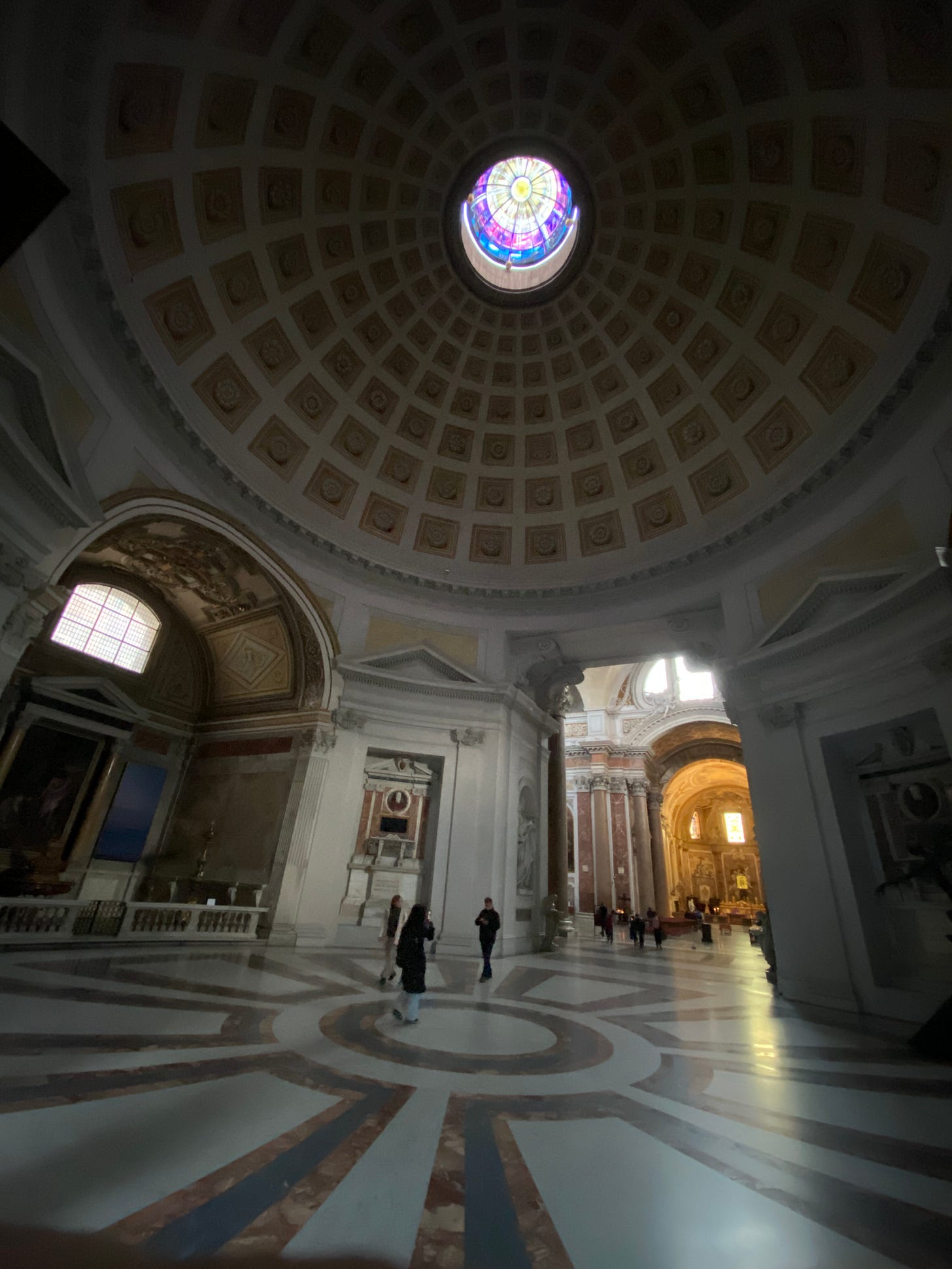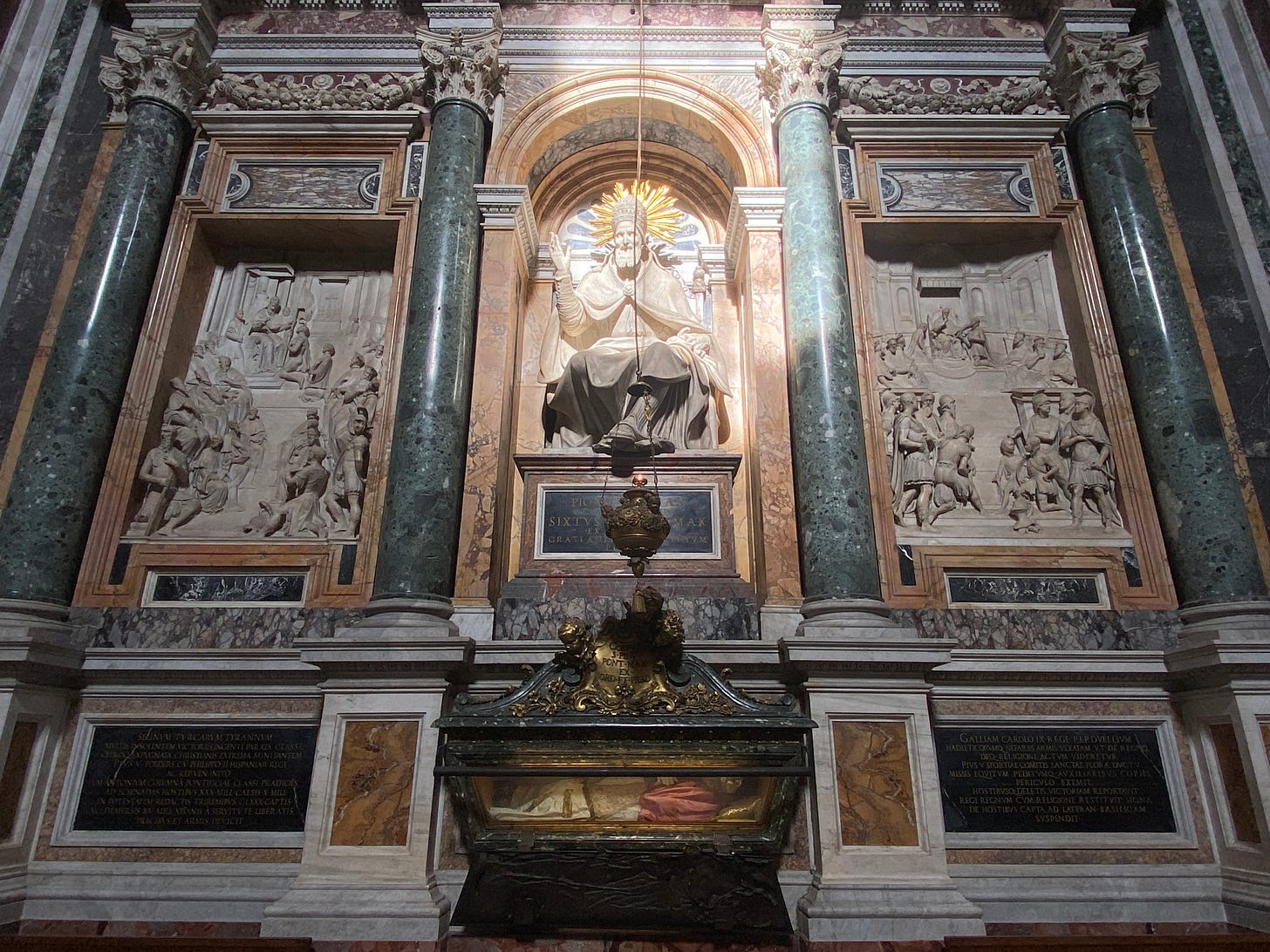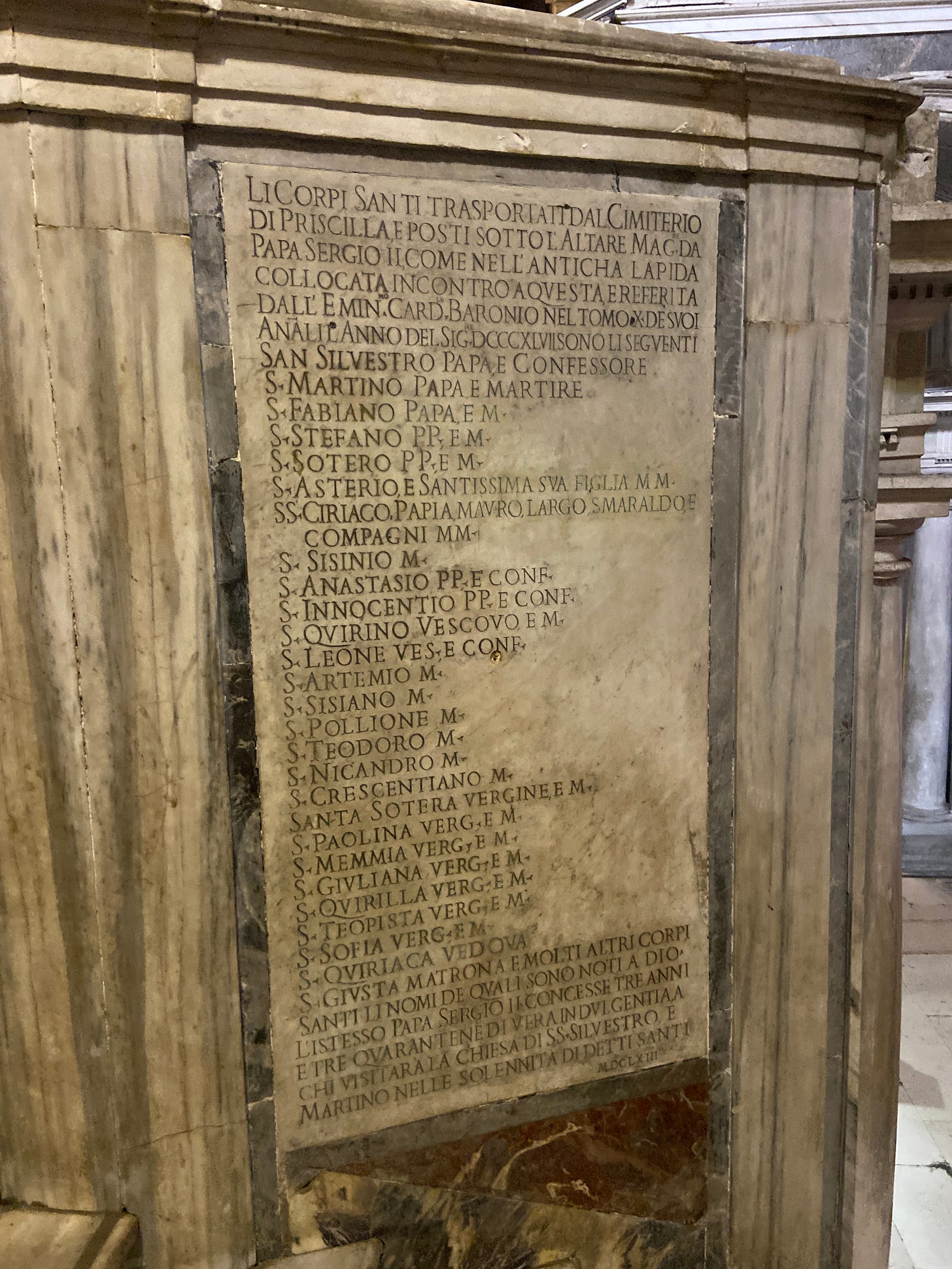Major churches and major beauty: Day 2 from Rome
Today in Papal History will be posting from Rome through the end of next week
What we have is given by God, and to teach it to others is to return it to Him.
- Gian Lorenzo Bernini
Day 2 began with Mass with other American pilgrims, seminarians, and priests at the Church of St. Vitalis, a beautiful ancient church that was dedicated in the 5th Century by Pope St. Innocent I and was once the titular parish of St. John Fisher, the 16th Century Bishop of Rochester who was martyred by the regime of King Henry VIII of England.
My friend and host, Fr. Ned, concelebrated with the other priests in attendance, and afterward he was off to four hours of canon law classes, so I ventured out into Rome solo for the first time.
After a coffee and chocolate croissant, my first stop was the Basilica of St. Mary of the Angels and of the Martyrs, a gorgeous baroque church hidden behind an old ruined facade of the Baths of Diocletian. The church itself was spectacular: a massive rotunda for the vestibule, followed by a sprawling nave twice as wide as it was long.
But placed oddly off to one side of the rotunda was a sculpture of I’m not sure what –it was random and out of place, at any rate.
As I stood staring at this work of modern/postmodern art, I began to reflect on the striking contrast between the sheer beauty I’d been seeing in Rome so far – and the same almost subconscious reaction to literally all of that beauty – and every ugly church and sculpture that can too often feel ubiquitous back home (aside from a few exceptions, the 60s and 70s weren’t kind to American Catholic architecture).
At its core, the juxtaposition in front of me was very clear. Everyone marvels at a centuries-old church, but few have their breath taken away by this sort of sculpture, and the only marveling being done is usually in figuring out what’s being depicted.
As I’ve continued to ponder that reaction to beauty and its antithesis, I’ve been reminded of St. Thomas Aquinas’ definition of objective beauty – that it must possess the threefold qualities of integritas (wholeness), consonantia (proportionality), and claritas (radiance/intelligibility) – described here in the context of church architecture by Dr. Denis McNamara of Chicago’s Mundelein Seminary:
Integritas, claritas, and consonantia prove critical in building a church, because as a theological and sacramental revelation of the new heaven and new earth, a beautiful church will provide a fullness of theological ideas but being complete not only in all of its functional parts, but also in its sacred imagery. Moreover, these parts will be proportional to their nature, showing not merely an earthly meeting hall, but an icon of a glorified reality, conventionally understood in architecture through sophistication of design, rich materials, and high levels of craft to be worthy of a church.
This worthiness and glorification is made knowable to the mind of the viewer, for whom the church building impresses into his or her mind the signs and symbols of heavenly realities. This participation in the liturgy is the aim to be considered before all else specifically because by perceiving heavenly realities in earthly matter, we have the opportunity to become heavenly ourselves, and we are suited to live happily with God for eternity.
There is a certain arrogance, it seems to me, in the insistence of so much of modern culture over the past half century that any architecture and artwork of the distant past is somehow beneath us – that we must continue to reinvent ourselves as a society and be wholly disconnected from our rich ancestry.
In that vein, I’ve found myself grateful for this tremendous patrimony of beauty – in Rome and where it’s been faithfully preserved elsewhere – along with the many thousands who come to see them each year. If nothing else, it serves as a humble refutation of such a poisonous belief.
—
Other highlights from Day 2:
Praying at the tomb of Pope St. Pius V in the Basilica of St. Mary Major, one of the four major Roman basilicas and the largest Marian church in the city. Pius V helped organize the fleet that won the pivotal Battle of Lepanto in 1571 and credited Mary under the title of Our Lady of the Victory as having interceded in the battle.
Praying (with the huge statue of Bl. Pope Pius IX) before the “Holy Crib” – the manger in which the infant Jesus was placed at the Nativity – which can be seen through glass beneath the high altar of St. Mary Major.
Visiting the Basilica of Santi Silvestro e Martino ai Monti (Sts. Sylvester and Martin in the Monti neighborhood of Rome), specifically the crypt beneath the main church. A chapel dedicated to St. Sylvester was constructed and dedicated in the 6th Century by Pope St. Symmachus, along with a mosaic above the altar that dates to the same period.

In the same basilica, at the top of the steps down into the crypt, was this inscription detailing all of the saints who had previously been buried in the Cemetery of Priscilla elsewhere in Rome, but had apparently been moved by Pope Sergius II (third line down - “PAPA SERGIO II”) in the 9th Century, possibly under the main altar in this very church.
At any rate, it didn’t appear that the tombs remained there, but (according to the bottom of the inscription) Sergius II granted special graces to pilgrims who visited the church on the feasts of these saints – which includes several sainted pontiffs:
San Silvestro - Pope St. Sylvester I
S. Martin - Pope St. Martin I, the last martyred pope in history
S. Fabiano - Pope St. Fabian, the pope who was elected from a bird landing on his head
S. Stefano - Pope St. Stephen I
S. Soter - Pope St. Soter
S. Anastasio PP - Pope St. Anastasius I
S. Innocentio PP - Pope St. Innocent I
In the Church of St. Agnes, Pope Innocent X is entombed above this huge door. I almost missed it until Fr. Ned pointed to it and said it looked “kinda tomb-y” – sure enough, upon further review, Innocent is indeed buried way up there.
Interestingly enough, Innocent X is the man whose likeness was used by artist Guido Reni in perhaps the most famous painting of St. Michael the Archangel in existence.
But it wasn’t St. Michael who bore the face of Innocent X…it was the devil.
As the story goes, when the future Innocent was still a cardinal, he was Pope Urban VIII most bitter rival, so the latter’s brother commissioned Reni’s painting, and presumably the very clear likeness of Innocent along with it.
Easily a major highlight of the whole trip – we ventured to St. Peter’s Basilica in the afternoon and were able to walk through the crypt containing a ton of extant papal tombs.
Unfortunately, my phone died halfway through St. Peter’s, so I’ll post a full digest and more reflections on the center of Catholicism specifically on a later day this week.
Thanks again for reading. See you tomorrow!













